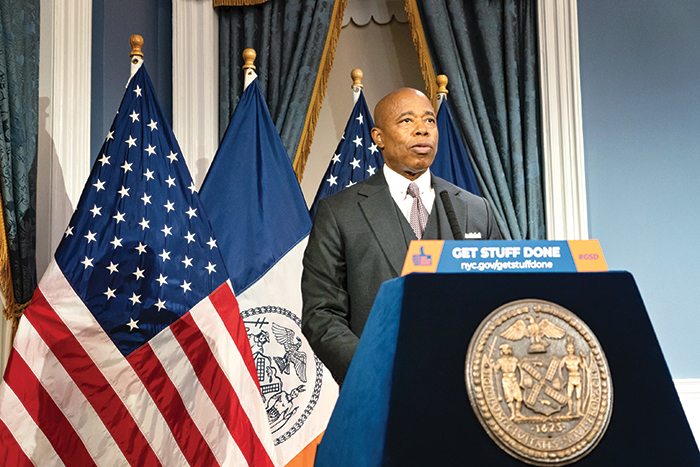Photo Courtesy of Caroline Willis/Mayoral Photography Office
“Sandy wasn’t just a storm; it was a warning,” Mayor Adams said.
By Forum Staff
Mayor Eric Adams on Wednesday marked the upcoming 10-year anniversary of Superstorm Sandy by taking a number of critical steps to build the long-term resilience of New York City. First, Mayor Adams broke ground on the Brooklyn Bridge-Montgomery Coastal Resilience (BMCR) project, which will install a combination of flood walls and deployable flip-up barriers to protect the Two Bridges neighborhood of Manhattan from a 100-year coastal storm surge, accounting for sea level rise expected by 2050, while also maintaining access and visibility to the waterfront.
Additionally, the Adams administration announced a new program — Climate Strong Communities (CSC) — as part of the city’s strategic climate strategy. A central initiative of AdaptNYC, CSC is a community engagement and project development program that will help create the next pipeline of resiliency projects that target multiple types of hazards. It will focus on neighborhoods that did not benefit from existing or planned Sandy recovery projects.
Mayor Adams also called on the federal government to create a coastal infrastructure formula funding program that will provide approximately $8.5 billion in pre-disaster mitigation grant funding to enable New York City to complete critical resiliency projects, including the following:
Coney Island Creek Raise Shoreline
Bushwick Inlet Park
Coney Island Boardwalk & Beach
East Harlem Coastal Resiliency
Financial District and Seaport Climate Resilience Master Plan
Manhattan Waterfront Greenway
Wetlands Management Framework for New York City
Forest Management Framework for New York City
Tibbets Brook Daylighting Project
Raise Shorelines 2.0
Superstorm Sandy measured 1,000 miles wide and took a rare westward hook that put New York City in the path of its onshore wind. It made a historic impact on the city, making landfall on October 29, 2012. With a wind field three times the size of Hurricane Katrina, Superstorm Sandy resulted in the deaths of 44 New Yorkers, flooded 51 miles (71 percent) of city land, left 2.5 million residents without power, resulted in $19 billion in damages and lost economic activity, rendered 35,000 residents temporarily or permanently displaced, and caused damage to more than 9,100 homes.
In recognition that several construction projects need faster groundbreakings and completions, Adams also on Wednesday pledged to work with state lawmakers to pass legislation that would empower the city to use progressive design-build. State law currently requires a two-step procurement process: One step for a request for qualifications and another for a request for proposals. With the passage of progressive design-build, the city can quickly select a vendor before the full scope of the project has been established. This would facilitate early-stage collaboration to investigate existing conditions, examine engineering and construction challenges, and agree on solutions before determining a final scope and price. Further, it would result in fewer disruptions for residents, fewer changes for contractors while projects are underway, money spent more efficiently, and better projects for New Yorkers.
“Sandy wasn’t just a storm; it was a warning,” Adams said. “Another storm could hit our city at any time and that is why our administration is doing everything we can to prepare and protect New Yorkers.”

